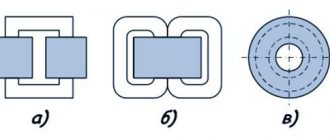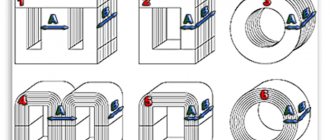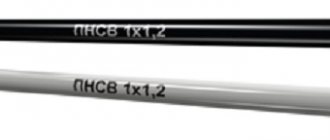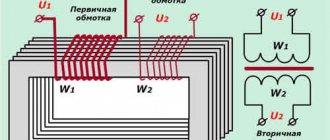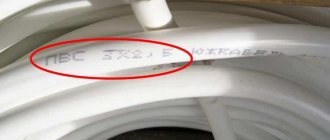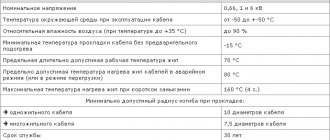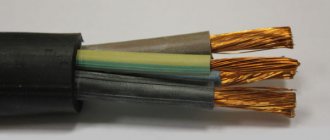Electricity is supplied to consumers over considerable distances. In this case, a certain voltage level is used, the value of which is brought to normal due to the operation of a TMG type power transformer. The technical decoding of the device indicates the type of device: T - three phases, M - oil and air cooling, G - tightness. In other words, TMG is a power three-phase oil sealed transformer for equalizing voltage in alternating current networks.
Transformer TMG
Principle of operation
TMG power plants are irreplaceable and reliable devices. The principle of operation of the units is to bring the voltage value to an acceptable value in the process of induction of an alternating current electromagnetic field (leveling), avoiding surges and instability. This is achieved thanks to its design and technical characteristics.
Transformer operating principle
A transformer is a static device that converts current and voltage through mutual induction. Layer windings of primary and secondary voltage are initially placed on a frame made of electrical steel. When the secondary winding opens, the primary winding receives voltage and creates a magnetic field with a flux that closes along the core. The magnetic flux meshes with the turns of the windings, due to which the electromotive force is brought back to normal, and the voltage in the network is 220 V.
In this case, the recommended winding connection is star. No-load losses are 15%, and the rated voltage reaches 0.4-0.35 kV. During operation, the unit is cooled by oil located in a sealed tank, the temperature of which is automatically regulated, preventing overheating.
All about energy
The name (or rather, nomenclature) of the transformer speaks about its design features and parameters. If you know how to read the name of the equipment, you can only find out the number of windings and phases of the power transformer, type of cooling, rated power and voltage of the highest winding.
General recommendations
The nomenclature of transformers (decoding the alphabetic and digital designations of the name) is not regulated by any regulatory documents, but is entirely determined by the equipment manufacturer. Therefore, if the name of your transformer cannot be deciphered, then contact its manufacturer or look at the product data sheet. The following explanations of the letters and numbers of the names of transformers are relevant for domestic products.
The name of the transformer consists of letters and numbers, each of which has its own meaning. When deciphering the name, it should be taken into account that some of them may be absent from it altogether (for example, the letter “A” in the name of a regular transformer), while others are mutually exclusive (for example, the letters “O” and “T”).
Explanation of the names of power transformers
The following letter designations are accepted for power transformers [1, p.238]:
Table 1 - Explanation of letter and digital designations for the name of the power transformer
| 1. Autotransformer | A |
| 2. Number of phases | |
| Single phase | ABOUT |
| Three-phase | T |
| 3. With split winding | R |
| 4. Cooling | |
| Dry transformers: | |
| natural airy when open | WITH |
| natural air with protected design | NW |
| natural air with sealed design | SG |
| air with forced air circulation | SD |
| Oil transformers: | |
| natural circulation of air and oil | M |
| forced air circulation and natural oil circulation | D |
| natural air circulation and forced oil circulation with non-directional oil flow | MC |
| natural air circulation and forced oil circulation with directed oil flow | NMC |
| forced air and oil circulation with non-directional oil flow | DC |
| forced circulation of air and oil with directed oil flow | NDC |
| forced circulation of water and oil with non-directional oil flow | C |
| forced circulation of water and oil with directed oil flow | NC |
| 5. Three-winding | T |
| 6. Branch switching | |
| on-load regulation (OLTC) | N |
| automatic control under load (ARLP) | AN |
| 7. Cast insulation | L |
| 8. Extender version | |
| with expander | F |
| without expander, with nitrogen blanket protection | Z |
| without expander in a corrugated tank (sealed packaging) | G |
| 9. With balun | U |
| 10. Suspended version (on an overhead line support) | P |
| 11. Purpose | |
| for own needs of power plants | WITH |
| for DC lines | P |
| for metallurgical production | M |
| for powering submersible electric pumps | Mon |
| for heating concrete or soil (concrete heating), for drilling rigs | B |
| for powering electrical equipment of excavators | E |
| for heat treatment of concrete and soil, power supply for hand tools, temporary lighting | THAT |
| mine transformers | Sh |
| Rated power, kVA | [number] |
| HV winding voltage class, kV | [number] |
| Voltage class of the MV winding (for auto- and three-winding tr-s), kV | [number] |
Note
: forced air circulation is called blowing, that is, “with forced air circulation” and “with blowing” are equivalent expressions.
Examples of deciphering the names of power transformers
TM - 100/35
— three-phase oil transformer with natural circulation of air and oil, rated power 0.1 MVA, voltage class 35 kV;
TDNS - 10000/35
- three-phase transformer with oil blowing, adjustable under load for the power plant’s own needs, rated power 10 MVA, voltage class 35 kV;
TRDNF - 25000/110
- three-phase transformer, with split winding, oil with forced air circulation, adjustable under load, with an expander, rated power 25 MVA, voltage class 110 kV;
ATDTsTN - 63000/220/110
- three-phase oil autotransformer with blowing and forced oil circulation, three-winding, adjustable under load, rated power 63 MVA, HV class - 220 kV, MV class - 110 kV;
AODTSTN - 333000/750/330
- single-phase oil autotransformer with blowing and forced oil circulation, three-winding, adjustable under load, rated power 333 MVA, HV class - 750 kV, MV class - 500 kV.
Explanation of the names of regulating (voltage booster) transformers
For control transformers, the following abbreviations are accepted [1, p.238][2, p.150]:
Table 2 - Explanation of alphabetic and digital designations of the name of the control transformer
| 1. Voltage booster transformer | IN |
| 2. Regulating transformer | R |
| 3. Linear adjustment | L |
| 4. Three-phase | T |
| 5. Cooling type: | |
| forced air circulation and natural oil circulation | D |
| natural circulation of air and oil | M |
| 6. Load regulation (OLTC) | N |
| 7. Lateral regulation | P |
| 8. Lightning-resistant design | G |
| 9. With reinforced input | U |
| Passing power, kVA | [number] |
| Excitation winding voltage class, kV | [number] |
| Voltage class of the control winding, kV | [number] |
Examples of deciphering the names of control transformers
VRTDNU - 180000/35/35
— booster transformer, regulating, three-phase, oil-cooled, type D, adjustable under load, with reinforced input, throughput power 180 MVA, rated voltage of the excitation winding 35 kV, rated voltage of the regulating winding 35 kV;
LTMN - 160000/10
- linear transformer, three-phase, with natural circulation of oil and air, adjustable under load, throughput power 160 MVA, rated line voltage 10 kV.
Explanation of the names of voltage transformers
For voltage transformers, the following abbreviations are accepted [2, p.200]:
Table 3 - Explanation of alphabetic and digital designations of the voltage transformer name
| 1. The end of the HV winding is grounded | Z |
| 2. Voltage transformer | N |
| 3. Number of phases: | |
| Single phase | ABOUT |
| Three-phase | T |
| 4. Insulation type: | |
| Dry | WITH |
| Oily | M |
| Cast epoxy | L |
| 5. Cascade (for NKF series)(1,2) | TO |
| 6. In a porcelain cover | F |
| 7. With winding to control network insulation | AND |
| 8. With capacitive divider (NDE series) | DE |
| Rated voltage(3), kV | [number] |
| Climatic performance | [number] |
- Note
- Accessory for the NOSC series;
- With compensation winding for NTMK series;
- In addition to the NOL and ZNOL series, in which:
:
- 06 - for installation in closed conductors, indoor switchgear and switchgear;
- 08 - for indoor and outdoor indoor and outdoor switchgear and switchgear;
- 11 - for explosive switchgear.
Examples of decoding names of voltage transformers
SOCK-3-U5
— single-phase voltage transformer with dry insulation, component, rated voltage of the HV winding 3 kV, climatic version — U5;
NOM-15-77U1
- single-phase voltage transformer with oil insulation, rated voltage of the HV winding 15 kV, developed in 1977, climatic version - U1;
ZNOM-15-63U2
- voltage transformer with a grounded end of the high-voltage winding, single-phase with oil insulation, rated voltage of the high-voltage winding 15 kV, developed in 1963, climatic version - U2;
ZNOL-06-6U3
- voltage transformer with a grounded end of the high-voltage winding, single-phase with cast epoxy insulation, for installation in closed conductors, indoor switchgear and switchgear, climatic version - U3;
NTS-05-UHL4
- three-phase voltage transformer with dry insulation, rated voltage of the HV winding 0.5 kV, climatic version - UHL4;
NTMK-10-71U3
- three-phase voltage transformer with oil insulation and compensation winding, rated voltage of the HV winding 10 kV, developed in 1971, climatic version - U3;
NTMI-10-66U3
- three-phase voltage transformer with oil insulation and winding for monitoring network insulation, rated voltage of the HV winding 10 kV, developed in 1966, climatic version - U3;
NKF-110-58U1
- cascade voltage transformer in a porcelain cover, rated voltage of the HV winding 110 kV, developed in 1958, climatic version - U1;
NDE-500-72U1
- voltage transformer with a capacitive divider, rated voltage of the HV winding 500 kV, developed in 1972, climatic version - U1;
Explanation of the names of current transformers
For current transformers, the following abbreviations are accepted [2, p.201,206-207,213]:
Table 4 - Interpretation of alphabetic and digital designations of the name of the current transformer
| 1. Current transformer | T |
| 2. In porcelain cover | F |
| 3. Type: | |
| Built-in(1) | IN |
| Generator | G |
| Zero sequence | N |
| Single turn | ABOUT |
| Passable(2) | P |
| Reinforced | U |
| Tire | Sh |
| 4. Winding design: | |
| Link type | Z |
| U-type | U |
| Latch type | R |
| 5. Insulation performance: | |
| Cast | L |
| Oily | M |
| 6. Air cooling(3.4) | IN |
| 7. Ground fault protection of individual cable cores(5) | Z |
| 8. Performance category | A, B |
| Rated Voltage(6.7) | [number] |
| Thermal current(8) | [number] |
| Climatic performance | [number] |
- Note
- For the series TV, TVT, TVS, TVU;
- For the TNP, TNPSh series - with alternating current magnetization;
- For the TShV, TVG series;
- For TVVG - 24 - water cooling;
- For the TNP, TNPSh series;
- For the TV, TVT, TVS, TVU series - the rated voltage of the equipment;
- For the TNP, TNPSh series - the number of cable cores to be wrapped around;
- For the TNP, TNPSh series - rated voltage.
:
Examples of deciphering the names of current transformers
TFZM - 35A - U1
— current transformer in a porcelain cover, with a link winding, oil insulated, rated voltage of the HV winding 35 kV, category A, climatic version U1;
TFRM - 750M - U1
- current transformer in a porcelain cover, with a link winding, with oil insulation, rated voltage of the HV winding 750 kV, climatic version U1;
TSHL - 10K
- bus current transformer with cast insulation, rated voltage of the HV winding 10 kV;
TLP - 10K - U3
- current transformer with cast insulation, feed-through, rated voltage of the HV winding 10 kV, climatic version - U3;
TPOL - 10
- feed-through current transformer, single-turn, with cast insulation, rated voltage of the HV winding 10 kV;
TSHV - 15
- busbar current transformer, air-cooled, rated voltage of the HV winding 15 kV;
TVG - 20 - I
- air-cooled current transformer, generator, rated voltage of the HV winding 20 kV;
TShLO - 20
- bus current transformer, with cast insulation, single-turn, rated voltage of the HV winding 20 kV;
TV - 35 - 40U2
- built-in current transformer, rated voltage of the HV winding 35 kV, thermal resistance current 40 kA, climatic version - U2;
TNP - 12
- zero-sequence current transformer, with alternating current bias, covering 12 cable cores;
TNPSh - 2 - 15
- zero-sequence current transformer, with alternating current bias, busbar, covering 2 cable cores, rated voltage of the HV winding 15 kV.
List of sources used
- Handbook for designing electrical networks / ed. D.L. Faibisovich. — 3rd ed., revised. and additional - Moscow: ENAS, 2009. - 392 p.: ill.
- Handbook of High Voltage Electrical Installations / ed. I.A. Baumshteina, S.A. Bazhenova. — 3rd ed., revised. and additional - Moscow: Energoatomizdat, 1989. - 768 p.: ill.
Design
The TMG case is durable and sealed, withstanding long-distance transportation. The unit is small in size, has a reliable sealed housing to protect the magnetic circuit and a durable mechanism. The unit is capable of operating under temperature fluctuations from +40 to -60 degrees. In this case, a non-explosive environment and protection from dust must be ensured.
Also read: Instrument current transformer
The design consists of the following components:
- Core made of special steel.
- Insulated metal winding, with high and low voltage inputs, magnetic circuit and high voltage switch.
- Coil with rated voltage.
- Corrugated sealed closed tank, with an oil filling level from 470 to 1570 ml and an oil level indicator.
- Thermometer for monitoring oil layer temperature.
- Safety valve and switch without excitation.
- Air dryer with expansion.
There is also a ground plate and drain plug at the bottom of the oil tank. The technical parameters of the TMG are indicated by the manufacturer on the outside of the unit in the form of a plate.
The net weight of the transformer is 280-920 kg, and with oil - 320-980 kg. The average dimensions of the unit are 1000x500mm.
TMG device
The power transformer includes the following components:
- sealed corrugated tank;
- high and low voltage inputs;
- the active part, consisting of a magnetic core, windings, and a high-voltage switch;
- oil level indicator;
- a thermometer, which is used to control the temperature of the oil layers located on top;
- safety valve;
- switch without excitation;
- expander with air dryer.
The oil transformer is sealed and filled with transformer oil, which is used to cool the unit. The tightness in TMG transformers prevents the oil from coming into contact with air and oxidizing, so power oil transformer installations do not require complex maintenance measures, such as constant preventative repairs and inspections.
We will consider measures for maintenance and operation of the device below.
Classification
TMG is divided into the following main types:
- Regarding appointments:
- intermediate
- measuring;
- protective;
- laboratory
- According to the installation method:
- external;
- internal;
- portable;
- stationary;
- tire;
- supporting
- By number of steps:
- single stage;
- cascading.
- By voltage rating:
- high voltage;
- low voltage.
- For winding insulation:
- dry;
- paper-oil;
- compound.
The power transformer is measured in kW units, and is used as a transformer substation kit.
Specifications
TMG power oil transformers are characterized by stable operation and high power. All this is achieved thanks to the technical indicators of the unit with GOST - 11677-85.
Technical characteristics of the TMG type transformer (to enlarge the table, click on it)
Table with characteristics for the TMG-1600 transformer
More detailed characteristics and dimensions can be found in the file: Open file
Transformer TMG 11
Three-phase oil transformers of the 11th series of hermetically sealed design without oil conservators are designed for converting electricity in the networks of power systems and electricity consumers. The neutral input of the LV side of the transformer is designed for continuous load with a current equal to 100% of the rated current of the LV winding. Their main difference from the TMG transformers is that the TMG11 has much lower no-load losses, while maintaining compact dimensions.
You can get more detailed information by downloading the PDF file
Description pdf, 165.43 KB
Order
I'll order later
{catalog::form[transformers](transformator-tmg-11)} Top
Device price
The cost of the unit depends on the type, area of its purpose and dimensions. Household transformers in the Russian Federation can be purchased from 14,000 to 21,000 rubles - the price depends on the region. For example, production amounts in 2022 in rubles:
- TMG-25 11 – 69 500;
- TMG-40 11 – 78 500;
- TMG-100 11 – 103 700;
- TMG-1000 11 – 413,500.
Also read: Three-phase oil transformer - TMF
It is best to purchase devices from domestic manufacturers. At the moment they are the best.
Marking
The alphanumeric designation of a transformer characterizes its quality characteristics, voltage class and power. There are different types of markings.
All TMG symbols are divided by 1/2/3/4.5, where:
- Amount of power.
- Nominal HV.
- Nominal NN.
- Climatic version, category according to GOST.
Decoding the TMG transformer markings
TCM transcript
Transformer calculation
These electromagnetic devices are designed for three-phase circuits and are made without additional cooling, that is, dry. Their power ranges from 0.16 to 1 kVA, most often used for rectifiers and semiconductor power supplies. One of the advantages of such a device is that it can be located in the housing in any position, horizontal or vertical.
The decoding of its markings is as follows:
T - three-phase;
C - dry;
M - multi-purpose.
After which its power and additional conditions of climatic use are indicated.
In industry and in everyday life, many dry and oil-based transformers for various purposes are used. If there is a factory plate on them, then deciphering it is not difficult. The main thing is to apply it in accordance with the type of electrical installation, power, and also that the voltages and currents of all windings are used under normal conditions without overloads. Then these unpretentious, reliable and low-maintenance devices can last for decades.
Purpose and scope
TMGs are used in various conditions, but the purpose depends on the placement category, determined by the parameters: 2, 3, 4 and the installation altitude above sea level, which should not be higher than 1000 m.
Units with a power from 1000 to 2500 kVA, with pressure gauge signaling thermometers, are intended for use under a canopy and indoors at temperatures from -40 to +60 degrees.
The devices cannot be used in conditions of strong vibration, possible mechanical shock, chemically active or explosive environments. It is recommended to install dry transformers or devices with built-in protection relays near flammable objects, as well as in hot climates.
Experienced craftsmen for production needs advise using models like SESH, which equalize the voltage and at the same time save energy.
Transformer tzlm decoding
Features of the application and operation of various transformer protections
TZLM is a zero-sequence current transformer, which is designed to be installed directly on a cable. The output voltage and current from it are used in relay protection systems to prevent ground faults in one of the three cable cores. TZLM is made in a cast housing and has special installation conditions, both climatic and directional installation features. TZLM can be installed indoors or outdoors, depending on the modification.
TZLM stands for:
T - current transformer;
Z - Earth, that is, from ground fault protection;
L - in a cast sealed housing;
M - Modernized.
Further, the TZLM marking contains numbers that indicate the design number, after which the climatic conditions of its use are indicated (letters U or T) temperate or topical climate.
Requirements for operation
To use and inspect the unit for the purpose of maintenance, it is necessary to strictly observe safety precautions in protective work clothing, a mask, and dielectric gloves. The indoor transformer must be installed in a dry room with a floor-mounted type, and at the beginning of operation the TMG frequency must be 50 Hz.
Do not start the device if you know about its external damage in the form of holes and dents. When checking equipment, the power supply in the networks is temporarily interrupted. Before use, check the oil level to ensure there is no leakage. It is also necessary to check the operation of the voltage switch. Adjustment is possible in the range – ± 5%.
Also read: Features and why sovtol transformers are being replaced
Maintenance and checking the operation of the device must be carried out with the device turned off.
TMG 12
Solving pressing issues of energy saving, UE “METZ IM. IN AND. KOZLOVA" offers a new development - TMG12 transformers with a power of 250 ... 1250 kVA The level of no-load and short-circuit losses in this series of transformers is established
in accordance with the recommendations of the European Committee for Electrotechnical Standardization (CENELEC) and is reduced (compared to transformers of other series, as well as transformers from other manufacturers), which allows significantly
reduce costs during equipment operation. At the same time, the noise characteristics of transformers have been improved.
Three-phase oil transformers TMG12 are designed for converting electricity in power supply networks and electricity consumers in outdoor or indoor conditions in a moderate (from plus 40 to minus 45 °C) or cold (from plus 40 to minus 60 °C) climate. The environment is non-explosive and does not contain dust in concentrations that reduce the parameters of products within unacceptable limits. Transformers are not designed to operate in conditions of shaking, vibration, shock, or in a chemically active environment. The installation height above sea level is no more than 1000 m.
Nominal frequency 50 Hz. Voltage regulation is carried out in a range of up to ±5% on a completely disconnected transformer (PBV) by switching the branches of the HV winding in steps of 2.5%.
TMG12 transformers are hermetically sealed, without oil conservators. Temperature changes in oil volume are compensated by changes in the volume of the tank corrugations due to their plastic deformation.
To monitor the oil level in transformers, a float-type oil indicator is provided. At the customer's request, to monitor the internal pressure in the tank and alarm if it exceeds the permissible values in transformers located indoors, an electric contact pressure-vacuum gauge is installed. To measure the temperature of the upper layers of oil and control external electrical circuits, transformers are equipped with a pressure gauge signaling thermometer upon customer request.
The neutral input of the LV side of the transformer is designed for a continuous load with a current equal to 100% of the rated current of the LV winding.
Transformers are equipped with transport rollers to move the transformer in the longitudinal and transverse directions. When installing rollers, dimensions H, H1 (see table) increase by 25 mm.
Technical characteristics of TMG12 transformers
Winding connection diagram and group - U/Un-O, D/Un-11
Transformer type
| Nom. power, kVA | Rated voltage, kV | Losses, W | Short-circuit voltage, % | Correct. sound power level, dBA | price, rub. | ||
| VN | NN | H.H. | short circuit | ||||
| TMG12-250/10-U1(HL1) | 250 | 6; 10 | 0,4 | 425 | 3250 | 4,5 | 55 |
| TMG12-250/15-U1(HL1) | 15 | ||||||
| TMG12-400/10-U1(HL1) | 400 | 6; 10 | 0,4 | 610 | 4600 | 4,5 | 60 |
| TMG12-400/15-U1(HL1) | 15 | ||||||
| TMG12-630/10-U1(HL1) | 630 | 6; 10 | 0,4 | 800 | 6750 | 5,5 | 61 |
| TMG12-1000/10-U1(HL1) | 1000 | 6; 10 | 0,4 | 1100 | 10500 | 5,5 | 64 |
| TMG12-1250/10-U1(HL1) | 1250 | 6; 10 | 0,4 | 1350 | 13250 | 6 | 65 |
| TMG12-1250/15-U1(HL1) | 15 | ||||||
Dimensional and weight characteristics
| Transformer type | Dimensions, mm | Weight, kg | price, rub. | |||||||||||
| L | B | H | H1 | A | A1 | A2 | A3 | A4 | b | b1 | oils | full | ||
| TMG12-250/10-U1(HL1) | 1170 | 780 | 1365 | 1095 | 550 | 550 | 200 | 150 | 150 | 140 | 120 | 225 | 1000 | |
| TMG12-250/15-U1(HL1) | 1490 | |||||||||||||
| TMG12-400/10-U1(HL1) | 1330 | 850 | 1635 | 1370 | 660 | 660 | 265 | 150 | 150 | 140 | 105 | 325 | 1370 | |
| TMG12-400/15-U1(HL1) | 1770 | |||||||||||||
| TMG12-630/10-U1(HL1) | 1390 | 1000 | 1710 | 1400 | 820 | 820 | 230 | 135 | 135 | 170 | 160 | 440 | 1870 | |
| TMG12-1000/10-U1(HL1) | 1600 | 1000 | 1970 | 1595 | 820 | 820 | 230 | 135 | 135 | 160 | 150 | 720 | 2820 | |
| TMG12-1250/10-U1(HL1) | 1800 | 1110 | 2100 | 1655 | 820 | 820 | 230 | 135 | 135 | 190 | 90 | 860 | 3630 | |
User manual
Installation and commissioning of the TMG must be carried out by a specialist, in accordance with strict adherence to safety rules, instructions and “Regulations for the technical operation of power plants and electrical networks”:
- It is forbidden to work with the device without grounding, with a broken clamp and without proper repair.
- You cannot start a transformer that does not meet the required coolant oil level.
- Before adding oil, you must make sure that it meets the declared parameters and characteristics of the manufacturer, and has a quality certificate.
- Do not use oil that has been used for other purposes.
- Oil is topped up if necessary, with a breakdown voltage within 35 kV.
- If possible, it is advisable to check the operation of the floor-standing unit daily.
- TMG must be connected to the network with the specified current frequency.
- All acceptable forms of vibration must be eliminated.
- It is necessary to strictly observe the connection in accordance with the switching and starting diagram, after an external audit.
- It is also necessary to ensure the required microclimate in the room and exclude direct exposure to sunlight.
Maintenance and repair of TMG
Before pouring and topping up oil into the device, it is recommended to check that it has not been used previously. For each batch of oil that is poured and topped up into the device, it is necessary to have quality certificates from the supplier certifying the oil’s compliance with established standards and specifications. Information about the compliance of the oil supplied with the transformer is entered in the passport or transformer form. It is important to note that it is allowed to add oil to the device only with a breakdown voltage of up to 35 kV. Topping up is carried out as necessary.
Interesting video: Production of TMG transformers
Current repairs of transformers are carried out within the time limits established by the governing document “Rules for the technical operation of power plants and networks.” After completion of current equipment repairs, tests are carried out.
From the above description it is clear that TMG is unpretentious to use and requires minimal maintenance costs. In addition, the transformer device has a number of advantages, including an efficiency of up to 99%, excellent performance, as well as protection against overheating and short circuits.

